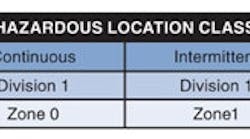ATEX directive 94/9/EC is the current European Community (EC) Harmonized Safety Compliance Directive and Standard. It is the law in the EU. Only EU certification agencies can certify products in accordance with the ATEX directive. What does this mean to you, a process control plant automation professional or a firm servicing process plant clients? You must be aware of where ATEX-certified products must be used in your plants worldwide, and be sure that any products you purchase to apply in hazardous areas are properly labeled.
Gus Elias, senior certification engineer with Moore Industries International, explains some of the main differences between U.S. and European requirements.
First you must establish the possibility of a hazardous atmosphere being present, its condition and duration. If an area doesn’t contain hazardous materials or potentially explosive atmospheres, it’s classified as a non-hazardous area or a safe location.
In Europe, compliance with ATEX Directive 94/9/EC is mandatory when installing and commissioning electronic or mechanical devices in hazardous locations. In many cases, legal requirements will not allow non-certified products to be placed in the field.
Also in Europe, hazardous areas are classified into three zones directly related to the predicted occurrence of an explosive atmosphere. These zones are Zone 0—Where an explosive atmosphere is continuously present or present for long periods; Zone 1—Where an explosive atmosphere is likely to occur in normal operation; and Zone 2—Where an explosive atmosphere is not likely to occur in normal operation, and if it does occur, it will exist only for a short time.
European standards also require that apparatus be subdivided into two groups. Group I apparatus is used in mines where the danger is methane gas and coal dust. Group II is for apparatus used in surface industries where the danger is gas and vapor that has been subdivided into three groups labeled A, B and C.
The table below compares U.S. and European practices.
Zone 2 (IEC/Europe) and Division 2 (U.S.) are similar, but not identical, while Division 1 includes the corresponding Zones 0 and 1. An instrument designed for Zone 1 can’t necessarily be used directly in Division 1, and no quantifications of the expressions “long period” for Zone 0, “can be present” for Zone 1 and Division 1, and “not normally present” for Zone 2 are given.
In common practice for Zone 0, a level of probability of a dangerous mixture present more than 1% of the time is generally accepted. Locations classified as Zone 1 have a level of probability of a dangerous mixture between 0.01% and 1% (maximum 100 hours per year). Zone 2 locations are considered dangerous when said mixture is present for no more than one hour per year.
The main difference between the U.S. and the European classification of hazardous locations is that there is currently no direct equivalent to the European Zone 0 in the U.S. system. However, existing standards may be revised to allow an equivalent representation. Zone 0 is therefore the most dangerous. An instrument designed for Zone 0 must be incapable of generating or accumulating sufficient energy to ignite the fuel mixture.
Electrical equipment that has been assessed, tested, and found compliant with the ATEX Directive and relevant European Harmonized Standards must be marked with the certification coding as described in the standards.




